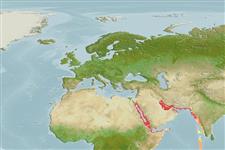Common names from other countries
Teleostei (teleosts) >
Ovalentaria/misc (Various families in series Ovalentaria) >
Pseudochromidae (Dottybacks) > Pseudochrominae
Etymology: Pseudochromis: Greek, pseudes = false + Greek, chromis = a fish, perhaps a perch (Ref. 45335).
More on author: Rüppell.
Environment: milieu / climate zone / depth range / distribution range
Ecology
Marine; reef-associated; depth range 2 - 30 m (Ref. 9710), usually 2 - 30 m (Ref. 27115). Tropical; 24°C - 28°C (Ref. 27115)
Western Indian Ocean: Red Sea and the Gulf of Aden.
Size / Weight / Age
Maturity: Lm ? range ? - ? cm
Max length : 7.2 cm TL male/unsexed; (Ref. 8883)
Occurs usually around bases of small rocks or coral heads on sandy bottoms. Has been reared in captivity (Ref. 35411).
Life cycle and mating behavior
Maturity | Reproduction | Spawning | Eggs | Fecundity | Larvae
Bi-directional sex change has been confirmed for this species (Ref. 103751).
Randall, J.E., 1986. Red Sea reef fishes. London, Immel Publishing. 192 p. (Ref. 8883)
IUCN Red List Status (Ref. 130435)
CITES (Ref. 128078)
Not Evaluated
Threat to humans
Harmless
Human uses
Aquarium: commercial
More information
Age/SizeGrowthLength-weightLength-lengthLength-frequenciesMorphometricsMorphologyLarvaeLarval dynamicsRecruitmentAbundance
ReferencesAquacultureAquaculture profileStrainsGeneticsElectrophoresesHeritabilityDiseasesProcessingMass conversion
Tools
Special reports
Download XML
Internet sources
Estimates based on models
Preferred temperature (Ref.
115969): 24.6 - 29.3, mean 27.2 (based on 238 cells).
Phylogenetic diversity index (Ref.
82804): PD
50 = 0.5000 [Uniqueness, from 0.5 = low to 2.0 = high].
Bayesian length-weight: a=0.01148 (0.00439 - 0.03002), b=3.01 (2.78 - 3.24), in cm Total Length, based on LWR estimates for this (Sub)family-body shape (Ref.
93245).
Trophic level (Ref.
69278): 3.5 ±0.50 se; based on food items.
Fishing Vulnerability (Ref.
59153): Low vulnerability (10 of 100).
